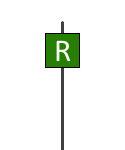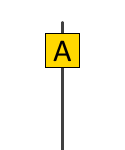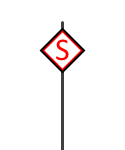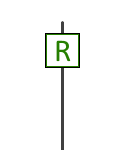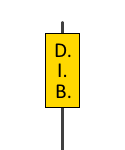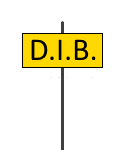User:YamaOfParadise/Tagging in North America
| This page is still under construction and is incomplete; there is a significant amount of data to cover because of the number of railroads in North America, so please contribute! Proposed tagging structures for OpenRailwayMap may be included in this article for documentation, and will be clearly delineated when present. |
The purpose of this page is to provide more specific tagging information for the United States, in addition to tabulating data that can be incorporated into OSM or used as a resource. It is broken down into two main sections. The section "National Overview and General Tagging" gives an introduction and overview to the U.S. portions of the North American railroad network, U.S. railroad standards, and how to tag them. The section "Individual Railroad Overview and Specific Tagging" gives specific railroad-by-railroad information; this includes a short overview of individual railroads, (OSM-relevant) operating/signal rules, and other tagging dependent on specific railroads. In addition, anomalies from railroad standards will be covered throughout this page.
National Overview and General Tagging
Tagging
Historical Mapping and Tagging
The railroad had a significant impact on how and where cities and towns were settled and developed in North America, in addition to having a significant cultural impact. U.S. railroad mileage peaked at 254,000 miles in 1914; as of 2008, there are approximately 140,000 miles still extant, leaving approximately 114,000 miles of former railroad routes just in the U.S. The majority of these routes still leave lasting remnants on the ground, and leave long-standing geographic marks that can be seen by aerial/satellite imagery. There are also a large number of historical societies and organizations that are dedicated to the history of specific railroads, and many other local organizations that seek to preserve their locality's railroad history. As a result of all of this, there is a lot of historical mapping that can be done with railroads that still adheres to the OSM principal of mapping what exists.
Individual Railroad Overview and Specific Tagging
Conventional Rail
Class I Freight
CSX Transportation
Norfolk Southern Corporation
Holding Companies
Delaware Otsego Corporation
New York, Susquehanna, and Western Railway
Genesee Valley Transportation
Genesee and Wyoming
Gulf and Ohio Railways
Iowa Pacific Holdings
Patriot Rail Corporation
Pioneer Railcorp
R.J. Corman Railroad Group
Watco Transportation Services
Independent Regional Railroads
Florida East Coast Railroad
Providence and Worcester Railroad Company
Independent Shortlines and Tourist Railroads
Finger Lakes Railway
Passenger Rail
Historic Railroad Systems
network:historic=*
Operating Rulebooks
NORAC
The Northeast Operating Rules Advisory Committee is both a rulebook and the organization that defines said rulebook. NORAC was formed in 1985 to create a common rulebook for the Northeast; operations became more complicated after the creation of Amtrak and Conrail, and after state and municipal agencies took over commuter rail operation and ownership. As such, NORAC has more ways to represent the same signal rule than any other set of operating rules in the United States. NORAC is a speed signalling system, and has the most speed signalling than any other rulebook. Those using NORAC have to use the rulebook in its entirety, with no additional rules.
workrules=US:NORACMembers and Membership Status
| Railroad Name | Abbreviation | Reporting Mark(s) | Membership Status | Passenger | Freight | Applicable Lines | Notes |
|---|---|---|---|---|---|---|---|
| Adirondack Scenic Railroad | fixme | fixme | Associate Member | Heritage/Tourist | fixme | fixme | |
| Amtrak | AMTK | Full Member | Passenger | No | Shore Line (New Haven to Boston) New York Terminal District Springfield Line (New Haven to Springfield) Philadelphia to Harrisburg Main Line (Keystone Corridor) New York Terminal District |
||
| Belfast and Moosehead Lake Railway | B&ML | BML | Associate Member | Heritage/Tourist | Rights to | Belfast and Moosehead Railroad | |
| Cape Cod Central Railroad | |||||||
| Cape May Seashore Lines | |||||||
| Claremont Concord Railroad | |||||||
| Columbia & Reading Railway | |||||||
| Finger Lakes Railway | FLGK | Associate Member | Heritage/Tourist | Common Carrier | fixme | ||
| Grafton & Upton Railroad Company | |||||||
| Housatonic Railroad | fixme | HRRC | |||||
| Maine Eastern Railroad | MERR | Associate Member | Heritage/Tourist | Common Carrier | Rockland Branch Lower Road |
||
| Massachusetts Bay Transit Authority | MBTA | MBTX | Full Member | Commuter | No | fixme | |
| Metro-North Railroad | fixme | fixme | Former Member | ||||
| Naugatuck Railroad | fixme | NAUG | Associate Member | Heritage/Tourist | fixme | fixme | |
| New Jersey Transit | NJT | NJTR | |||||
| New York, Susquehanna, and Western Railway | NYS&W | NYSW | Associate Member | No | Common Carrier | All | |
| Pan Am Railways | PAR | fixme | fixme Member | fixme | Common Carrier | fixme | |
| Providence and Worcester Railroad | P&W | PW | Full Member | Excursion | Common Carrier | fixme | |
| Southern Railroad of New Jersey | |||||||
| Seminole Gulf Railway | |||||||
| SMS Rail Service | |||||||
| Southeastern Pennsylvania Transportation Authority | SEPTA | SEPA | |||||
| Valley Railroad | VRR | VALE | Associate Member | Heritage/Tourist | Rights to | Valley Line | |
| Wellsboro & Corning Railroad | |||||||
| West Chester Railroad | |||||||
| Winimac Southern Railroad | |||||||
| Winnipesaukee Scenic Railroad | |||||||
Defined Terms
Signal System Types
<todo>
Speeds
| Name | Passenger | Freight | Notes |
|---|---|---|---|
| Normal Speed | The Maximum authorized speed. | ||
| Limited Speed | Not exceeding 45 MPH. | Not exceeding 40 MPH | |
| Medium Speed | Not exceeding 30 MPH | ||
| Slow Speed | Not exceeding 15 MPH | ||
| Restricted Speed | Not exceeding a speed that permits the movement to be stopped within 1/2 the range of vision short of any obstructions or signals requiring a stop. | ||
Operating Rules
Signalling Rules
Keyvalues are defined US-NORAC:<rule>, where the value of <rule> is defined in the table below.





















































